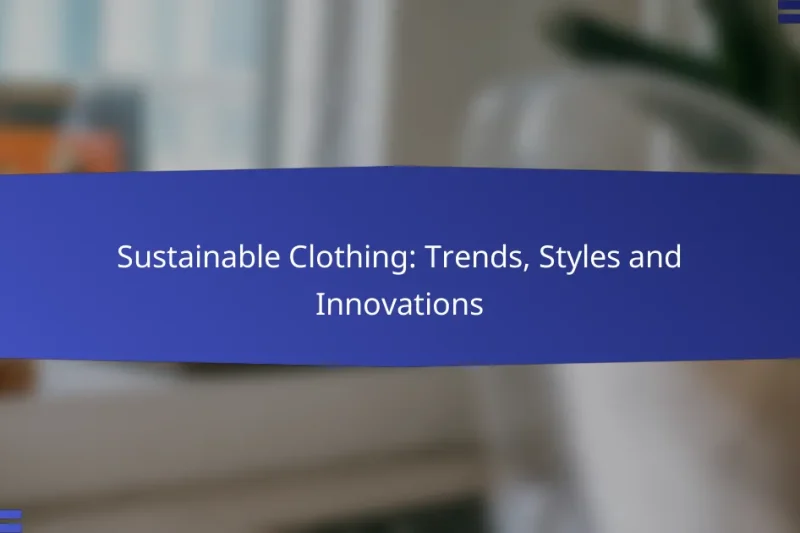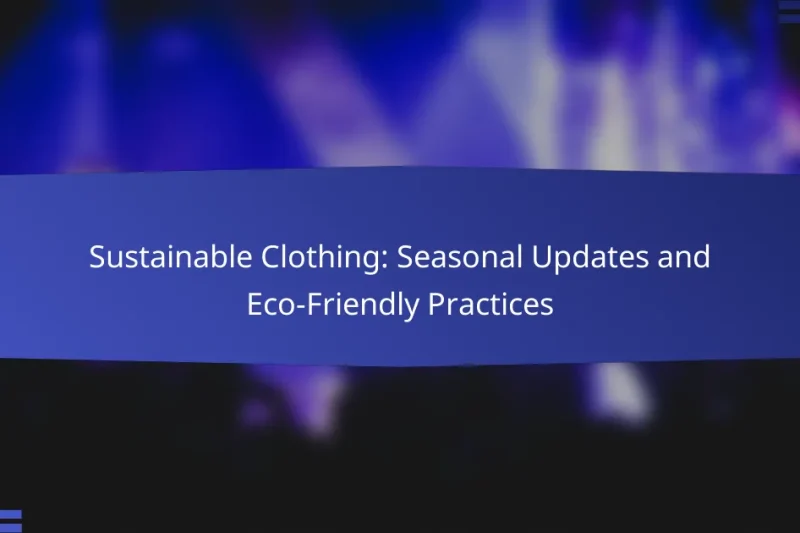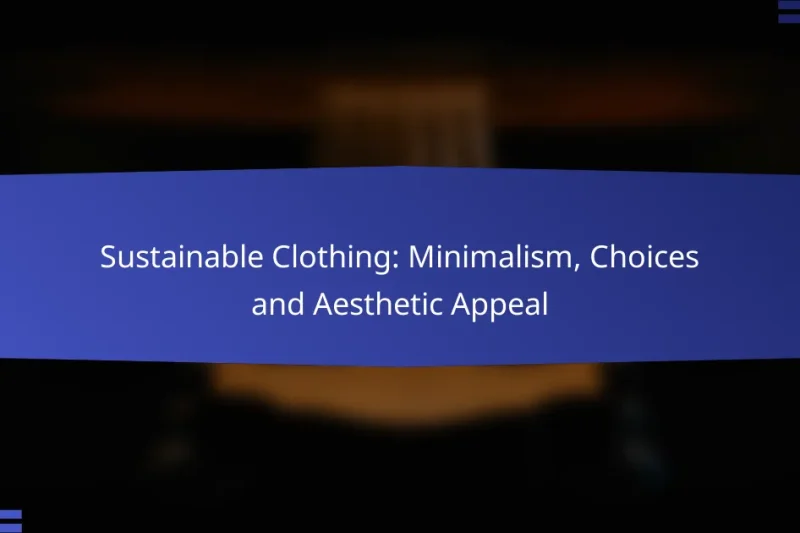Sustainable clothing is rapidly gaining traction as consumers increasingly seek eco-friendly materials and ethical production methods. … Sustainable Clothing: Trends, Styles and InnovationsRead more
Current Sustainable Fashion Trends
Current sustainable fashion trends emphasize eco-friendly practices and innovative materials, reflecting a growing consumer demand for responsible choices. Brands are adopting transparent supply chains and ethical production methods, which not only minimize environmental impact but also foster a more conscious approach to fashion. By embracing sustainability, consumers can support ethical labor practices and contribute to a healthier planet.
Sustainable Clothing: Upcycling Benefits and Eco-Friendly Choices
Sustainable clothing is gaining traction as consumers seek to minimize their environmental impact through eco-friendly choices. … Sustainable Clothing: Upcycling Benefits and Eco-Friendly ChoicesRead more
Sustainable Clothing: Seasonal Updates and Eco-Friendly Practices
Sustainable clothing is an essential choice for environmentally conscious consumers, emphasizing eco-friendly practices and ethical labor. … Sustainable Clothing: Seasonal Updates and Eco-Friendly PracticesRead more
Sustainable Clothing: Minimalism, Choices and Aesthetic Appeal
Sustainable clothing embodies the principles of minimalism by encouraging a curated wardrobe that focuses on essential, … Sustainable Clothing: Minimalism, Choices and Aesthetic AppealRead more
Sustainable Clothing: Celebrity Influence and Trend Impact
The influence of celebrities on sustainable clothing trends is profound, as their visibility helps to promote … Sustainable Clothing: Celebrity Influence and Trend ImpactRead more
Sustainable Clothing: Vintage Integration and Wardrobe Essentials
Sustainable clothing is increasingly gaining attention as consumers seek to reduce waste and promote eco-friendly fashion … Sustainable Clothing: Vintage Integration and Wardrobe EssentialsRead more
Sustainable Clothing: Style, Support and Fashion Movements
Sustainable clothing is revolutionizing the fashion industry by emphasizing eco-friendly practices and ethical consumption. By selecting … Sustainable Clothing: Style, Support and Fashion MovementsRead more
What are the current sustainable fashion trends in the UK?
Current sustainable fashion trends in the UK focus on eco-friendly practices, innovative materials, and ethical production methods. Consumers are increasingly prioritizing sustainability, leading to a rise in demand for responsible fashion choices.
Eco-friendly materials
Eco-friendly materials are at the forefront of sustainable fashion, with brands opting for organic cotton, hemp, and recycled fabrics. These materials reduce environmental impact by minimizing water usage and chemical inputs during production.
For example, organic cotton uses about 91% less water than conventional cotton. Brands are also exploring alternatives like Tencel and Piñatex, which are derived from sustainable sources and have a lower carbon footprint.
Upcycled clothing
Upcycled clothing involves repurposing old garments into new designs, reducing waste and promoting creativity. This trend encourages consumers to rethink their relationship with clothing, emphasizing quality over quantity.
Many UK brands are now offering collections made from upcycled materials, allowing customers to own unique pieces while contributing to sustainability. Thrift shops and online platforms for second-hand clothing also support this movement.
Minimalist designs
Minimalist designs focus on simplicity and functionality, promoting a “less is more” philosophy. This trend encourages consumers to invest in versatile pieces that can be worn in multiple ways, reducing the need for excessive wardrobes.
Brands embracing minimalist aesthetics often use neutral colors and timeless silhouettes, making it easier for consumers to mix and match. This approach not only simplifies fashion choices but also extends the lifespan of garments.
Rental fashion services
Rental fashion services allow consumers to borrow clothing for special occasions instead of purchasing new items. This trend is gaining popularity in the UK as it promotes sustainability by reducing waste and encouraging a circular economy.
Platforms like HURR Collective and My Wardrobe HQ offer a range of designer pieces for rent, making high-quality fashion accessible while minimizing environmental impact. Renting can be a cost-effective solution for those looking to refresh their wardrobe without the commitment of buying.
Local production
Local production focuses on creating garments within the UK, reducing the carbon footprint associated with long-distance shipping. This trend supports local economies and fosters transparency in the supply chain.
Brands that prioritize local production often emphasize ethical labor practices and quality craftsmanship. Consumers can look for labels that highlight their commitment to local sourcing, ensuring their purchases support sustainable practices.
How are brands adopting sustainable practices?
Brands are increasingly adopting sustainable practices by integrating eco-friendly materials, promoting transparency in their supply chains, and encouraging responsible consumer behavior. These approaches not only reduce environmental impact but also resonate with a growing consumer demand for ethical fashion.
Patagonia’s repair program
Patagonia’s repair program exemplifies a commitment to sustainability by encouraging customers to repair rather than replace their clothing. The company offers repair services and provides resources for DIY fixes, which helps extend the life of garments and reduces waste.
This initiative aligns with the brand’s philosophy of minimizing environmental impact and promotes a culture of sustainability among consumers. By making repairs accessible, Patagonia fosters a sense of responsibility towards the planet.
Everlane’s transparency model
Everlane has set a benchmark in the fashion industry with its transparency model, which details the true cost of each item, including materials, labor, and markup. This openness allows consumers to make informed decisions about their purchases and understand the ethical implications behind their clothing.
By showcasing factories and sharing information about their production processes, Everlane builds trust with customers and encourages a more conscious approach to fashion consumption. This model highlights the importance of ethical sourcing and fair labor practices.
Reformation’s eco-friendly collections
Reformation focuses on creating eco-friendly collections by using sustainable materials and practices in its production processes. The brand prioritizes organic cotton, recycled fabrics, and low-impact dyes, which significantly reduce its carbon footprint.
Additionally, Reformation provides a detailed impact report for each product, allowing customers to see the environmental benefits of their purchases. This transparency not only educates consumers but also promotes a shift towards more sustainable fashion choices.
What are the benefits of sustainable fashion?
Sustainable fashion offers numerous benefits, including a reduced environmental footprint, support for ethical labor practices, and the production of longer-lasting products. By prioritizing sustainability, consumers can make informed choices that positively impact the planet and society.
Reduced environmental impact
Sustainable fashion significantly lowers the environmental impact associated with clothing production. This includes reducing water usage, minimizing waste, and decreasing carbon emissions. For instance, brands that utilize organic materials often consume less water compared to conventional cotton farming.
Choosing sustainable fabrics, such as Tencel or recycled polyester, can further enhance these benefits. These materials often require fewer resources and produce less pollution during manufacturing, contributing to a healthier planet.
Support for ethical labor practices
Ethical labor practices are a cornerstone of sustainable fashion. Brands committed to sustainability often ensure fair wages, safe working conditions, and respect for workers’ rights. This approach fosters a more equitable industry and helps combat exploitation in garment production.
Consumers can support ethical practices by researching brands and looking for certifications, such as Fair Trade or Global Organic Textile Standard (GOTS). These labels indicate a commitment to ethical labor and environmental standards.
Longer-lasting products
Sustainable fashion emphasizes quality over quantity, resulting in longer-lasting products. By investing in well-made items, consumers can reduce the frequency of purchases, which in turn minimizes waste. High-quality garments often feature durable materials and craftsmanship that withstand wear and tear.
To make the most of sustainable fashion, consider timeless styles that won’t go out of fashion quickly. This approach not only extends the life of your wardrobe but also encourages a shift away from fast fashion habits.
How to choose sustainable fashion brands?
Choosing sustainable fashion brands involves assessing their environmental and ethical practices. Look for brands that prioritize eco-friendly materials, fair labor conditions, and transparency in their supply chains.
Look for certifications
Certifications can help identify sustainable fashion brands. Look for labels such as GOTS (Global Organic Textile Standard), Fair Trade, or OEKO-TEX, which indicate adherence to specific environmental and social standards.
These certifications often require brands to undergo rigorous testing and audits, ensuring that their products meet sustainability criteria. Checking for these labels can simplify your decision-making process.
Research brand practices
Investigating a brand’s practices is crucial for understanding its commitment to sustainability. Review their website and social media for information on sourcing, production methods, and labor policies.
Brands that are transparent about their practices often share stories about their supply chains and the people behind their products. Look for detailed reports or sustainability pledges that outline their goals and achievements.
Check for local sourcing
Local sourcing can significantly reduce a brand’s carbon footprint. Brands that source materials and manufacture products closer to home often have lower transportation emissions and support local economies.
When evaluating brands, consider those that highlight their local partnerships and regional production. This not only promotes sustainability but also fosters community development.
What are the challenges in sustainable fashion?
Sustainable fashion faces several challenges that hinder its widespread adoption. Key issues include higher production costs and varying levels of consumer awareness regarding sustainable practices.
Higher production costs
One of the main challenges in sustainable fashion is the higher production costs associated with eco-friendly materials and ethical labor practices. Brands often invest in organic fabrics, which can be significantly more expensive than conventional options.
Additionally, sustainable production methods may require advanced technology or more time-consuming processes, further driving up costs. This can lead to retail prices that are higher than those of fast fashion, making it less accessible to some consumers.
Consumer awareness
Consumer awareness plays a crucial role in the success of sustainable fashion. Many shoppers are still unaware of the environmental and social impacts of their clothing choices, which can limit demand for sustainable options.
Brands can address this challenge by educating consumers through marketing campaigns, transparency about sourcing and production, and highlighting the benefits of sustainable fashion. Engaging storytelling and clear labeling can help bridge the knowledge gap and encourage more responsible purchasing decisions.






